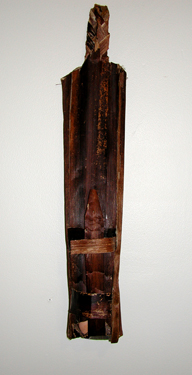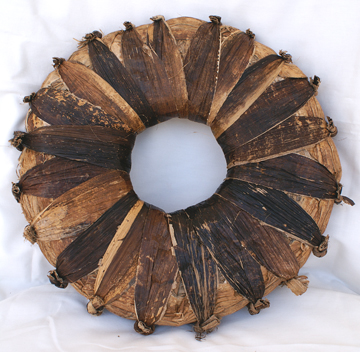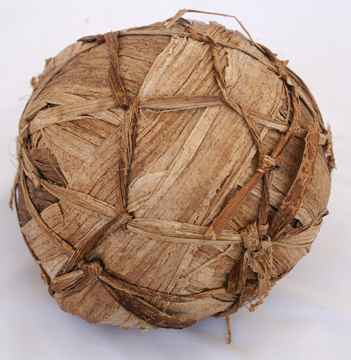David Stairs
The President of Uganda, H.E. Yoweri Kaguta Museveni, was recently on television discussing the economic development of the nation. Uganda is one of the poorest countries in the world, but you wouldn’t know this from listening to its leader. M7, as he is known hereabouts, extolled the God-given gifts of the Pearl of Africa. He reminded his viewers that Uganda is rich in natural resources. Water, for example, is a tremendous asset in Uganda where it rains 8-9 months each year. This results in up to potentially three harvests per annum, which is one of the reasons for Uganda’s continuing status as an agrarian country. It also is one of the reasons Uganda is exploited by the rest of the world as a provider of raw materials.

Bananaleaf egg holder
Coffee is Uganda’s premier cash crop. Uganda is the world’s fourth largest producer of coffee, and about ten percent of the population is involved in its production. Another bumper crop is bananas. It is an irony of history that bananas are not indigenous to East Africa, but were transferred here from southeast Asia several centuries ago. This was fortunate, as they now form a staple in the Ugandan diet. Ugandans eat lots of bananas, both fruit and starch (matooke) varieties. All one has to do to establish a banana forest is dig a few holes in the ground and stick banana branches in them. Banana trees are a great source of liquid and fiber, both dietary and commercial. Like the bison on the American plains, Ugandans use every part of the banana tree. Many Ugandan dishes, like their Central American counterparts, are prepared by steaming food wrapped in banana leaves. Banana leaves can also be used as hats or shields against rain, or on makeshift lean-tos.

Coffee & tobacco
Then there is the packaging aspect. A number of products are bound with banana leaves. At the market, spinach and other bunch vegetables are tied with banana fiber. It’s not uncommon to see street-vendors with bunches of coffee beans or tobacco in individually wrapped pouches bound together and thrown over a shoulder as they wend the city streets. These small portions sell for 300-500 shillings, or about 15-20¢ each. Then there’s the banana leaf egg carrier that a friend gave to me a few years ago. I’m sticking to known uses here, but I’m certain this list could go on, limited only by the reader’s imagination.

Headload pad
A recent trip to a local market uncovered a round banana leaf pad. Ugandans use these atop their heads as insulation against the head loads many of them carry. The article is made entirely of banana leaf, including the stuffing. I propose it as a good portable seat cushion for those long afternoons sitting on concrete at Mandela Memorial football stadium.

Wembley, or bananaleaf football
Which brings us to a most poetic application for banana fiber. Young boys deep in the village may not be wealthy enough to own a traditional leather soccer ball, but that doesn’t quell their love for the sport. A way around it is to firmly bind dried banana leaf fiber into a springy, responsive home made football, or “Wembley.” Sometimes a bicycle innertube is employed as the inflated bladder. Many aspiring, and more than a few semi-pro players in Uganda got their start with such a ball. Don’t care for football? Well, not to be outdone, Ugandan girls even make their dolls out of, you guessed it…banana fiber. And when they grow up there’s bananaleaf jewelry waiting for them.

Bananaleaf earrings and bracelet
The distinguished Indian designer MP Ranjan has written a whole book on the practical uses for bamboo in his country. It’s what we call doing the best with what you’ve got. Ugandans do much the same thing with banana leaves, and and the results are often amazing.
David Stairs is the founding editor of Design-Altruism-Project











March 5, 2007 at 5:49 am
I find it really interesting how innovative people can be with a material when they are limited to what is available to work with.
I recently made a presentation at the World Wool Awards in Cairo (2006) where I spoke about the nomadic peoples of Central Asia and the way they have managed to use wool fibre (in the form of felt) to make clothing, carpets, protective outerwear, hats, saddle blankets and even shelters (yurts). I tried to make a point (not sure how effectively) to the wool execs at this conference that rather than spending millions on various technologies and genetic “meddling” in an attempt to make the wool fibre more compatible with synthetics, they should devote some time to discovering what else can be done with wool as it is in it’s natural state. There are likely hundreds of uses that have yet to be discovered.
I believe that natural materials are not being used to their full potential because of the availability of so many crap synthetic materials.
As designers who aim to create sustainable products we should be looking at natural materials and learning how to exploit their unique properties to their fullest potential. The best people to learn about these materials from are the traditional peoples who have used them for generations and have a wealth of knowledge about how to work with these materials in a sustainable way to create products that meet various needs. The banana leaf article presents just another great example of the level of innovation put to finding uses for a locally available natural material.
Just in case anyone is interested specifically in natural fibres, 2009 is going to be the International Year of Natural Fibres and projects are being developed at the moment to promote natural fibres internationally. Check out the Food and Agriculture Organization of the United Nations website to learn more. http://www.fao.org/es/ESC/en/20953/22215/highlight_108451en.html
March 1, 2007 at 1:17 pm
Amongst all the daily hoo-ha about sustainability that marches straight through my head, one comment stuck recently. I was listening to Cameron Sinclair do his pitch when he said, “For 90% of the world, sustainability is not an option, it’s a necessity.” True. Sort of. Our models of success don’t usually nurture doing the best with what you’ve got. Instead, success is often measured by how much of that is superceded by molded PVC junk. What a pity.